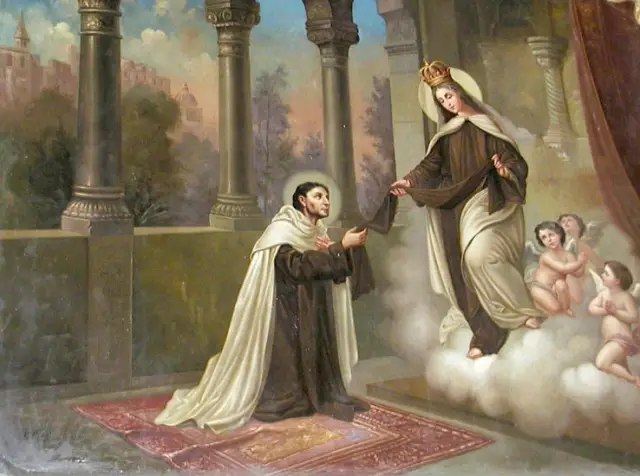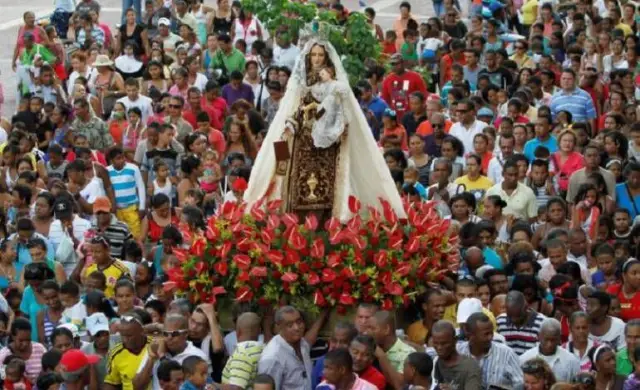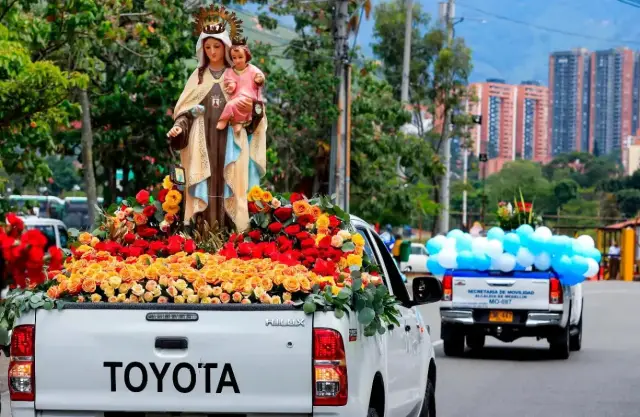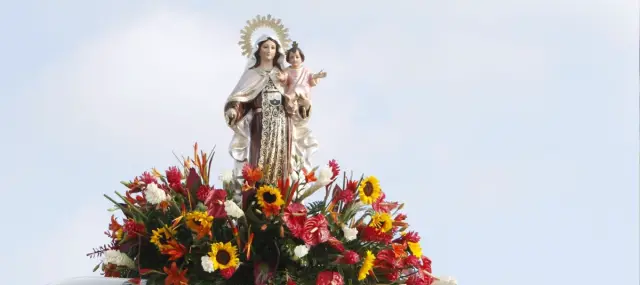Every July 16th , Colombia becomes a place of faith and celebration. This date marks the feast of Our Lady of Mount Carmel , one of the most venerated Marian devotions in the country. Considered the patron saint of drivers, transporters, firefighters, police officers, and the armed forces , her image is displayed on vehicles, in churches, and in streets. It is not an official holiday, but it is celebrated with deep devotion and tradition in towns and cities. In this article, we will explore the origin, history, and cultural expressions that make July 16th such a special day in the hearts of Colombians.
Origin and history of the Virgin of Carmen
1. Apparition to Saint Simon Stock
According to Catholic tradition, in 1251 , Our Lady of Mount Carmel appeared to Saint Simon Stock , a Carmelite monk who was praying fervently for help for his community. In this apparition, she gave him a scapular , a piece of cloth with profound spiritual significance, promising protection to whoever wore it with faith. Since then, July 16 has become the official liturgical date to honor her. The devotion quickly spread throughout Europe and later Latin America, eventually occupying a special place in the hearts of the Colombian people.
2. Propagation in Colombia
With the arrival of Spanish colonizers, devotion to the Virgin of Carmen was introduced into Colombian territory. Over the centuries, brotherhoods, confraternities, and temples were established in her honor, making her a central figure in popular Catholicism. Her presence was further consolidated during the 18th and 19th centuries, and in 1992 , the Catholic Church in Colombia strengthened this celebration by granting it the status of an official religious holiday in several dioceses across the country.

Cultural and symbolic meaning
Patron saint of guilds and forces
The Virgin of Carmen is recognized as the protector of the most dangerous occupations, such as land, sea, and air transportation, and emergency services. For this reason, many drivers, police officers, sailors, and firefighters place an image of the Virgin in their vehicles or at stations, as a sign of faith and a request for divine protection. This patron saint not only provides hope on a spiritual level, but also symbolizes solidarity and a sense of community among those involved in these high-risk occupations.
A community meeting point
In addition to its religious dimension, this celebration has become a cultural and social event that strengthens community ties. In many localities, activities include traditional foods, music festivals, parades, and commemorative events that generate a festive atmosphere. It is an opportunity for neighbors, families, and communities to gather, share stories, express gratitude, and strengthen their sense of belonging.
Traditions and celebration in different regions
In Colombia, July 16th is celebrated with enthusiasm and creativity. Traditions include novenas, Eucharists, processions, and vehicle caravans . One of the most moving moments of the day is the vehicle blessing , where drivers from all over the world attend with their cars decorated with flowers, white and blue balloons, religious images, and handkerchiefs. The caravans travel through the main streets, accompanied by music, applause, and singing.
In cities like Bogotá, Medellín, Barranquilla, and Cali, these celebrations have a more urban feel, while in towns like El Carmen de Bolívar , they are celebrated with unparalleled intensity. There, patron saint festivals include alboradas (a procession of prayers), porros (pork-baking), candela balls (balls of fire), burning of castles (castles), and multitudinous processions that draw thousands of faithful. These celebrations can last more than a week and become an important driver of local religious and economic tourism .
In other regions, such as Chimá (Pimental) or Corozal , the celebration is intertwined with local folklore traditions: dances, horse races, cockfights, and food festivals are organized. Each place imprints its own unique cultural stamp, enriching the diversity of ways of experiencing devotion to the Virgin of Carmen.

Transporter Day and its connection
July 16 is also recognized as Transporters' Day in Colombia , an unofficial but deeply symbolic commemoration. This coincidence is no coincidence: since the 1970s and 1980s, the transport industry has adopted the Virgin of Carmen as its patron saint and protector. Thus, public transport companies, drivers' associations, and cooperatives have made this date a day to reflect, express gratitude, improve road safety, and pay tribute to those who work long hours on the country's roads.
Many terminals, offices, and workshops organize recognition events, training sessions, plaque presentations , and fellowship gatherings among colleagues. It's a day to celebrate the importance of those who move Colombia forward from their steering wheels, engines, and roads.
Street signs: balloons and caravans
On July 16, the urban landscape changes noticeably. The streets fill with vehicles decorated with white and blue balloons , images of the Virgin of Carmen on the windshields, and holy cards hanging from the rearview mirrors. The caravans become a visual and auditory spectacle, with honking horns, religious music, and an atmosphere of respect and joy. For many drivers, this is a way to give thanks for the favors received during the year or to pray for a safe trip.
Why continue this tradition today?
In an increasingly fast-paced and technological world, keeping traditions like July 16th alive offers a bridge between the past and the present , between the spiritual and the everyday. This date not only strengthens the Catholic faith , but also recognizes the efforts of transportation workers, highlights the value of community, and promotes domestic tourism. It's also a perfect excuse to bring families, neighbors, and different generations together around a common cause. Participating in these festivities means joining a network of gratitude, protection, and culture that remains alive year after year.

A legacy that lives on
Beyond its religious significance, the celebration of July 16th has become a pillar of Colombian culture . With its colorful caravans, community festivals, and the fervor of thousands of devotees, this day unites Colombians in a collective expression of gratitude, protection, and hope . The Virgin of Carmen represents that link between faith and everyday life, between the past and new generations. Participating in this tradition means keeping alive a cultural heritage that continues to illuminate the streets and hearts of the country. Whether through spirituality or admiration for popular culture, it is worth experiencing, knowing, and passing on.
Frequently Asked Questions (FAQ)
Is July 16 a holiday in Colombia?
It is not an official holiday, but it is celebrated en masse and with great intensity in many regions, especially in towns with a strong Catholic tradition.Why is Transporter's Day celebrated on this date?
Because the Virgin of Carmen is the patron saint of drivers and transportation workers, they have adopted this date as a day of recognition and devotion.What is the origin of the scapular?
The scapular was given by the Virgin of Carmen to Saint Simon Stock as a promise of spiritual protection for those who wear it with faith.Where is July 16th celebrated with the greatest fervor?
The festivities in El Carmen de Bolívar are among the most intense in the country, but they are also celebrated with great devotion in Bogotá, Antioquia, Santander, and the Caribbean coast.Can someone who is not Catholic participate?
Yes, many of the activities are cultural, community-based, and open to the public. Everyone is welcome to enjoy the music, caravans, and festive atmosphere.
